α-Glucosidase Inhibitors Based on Oleanolic Acid for the Treatment of Immunometabolic Disorders
Abstract
1. Introduction
2. Materials and Methods
2.1. Chemistry
2.1.1. General
2.1.2. General Procedure for the Synthesis of Compounds 4 and 5
- 3,28-Di-O-[3-(3-methoxyphenyl)acrylate]-olean-12(13)-en 4
- 3,28-Di-O-[isonicotinate]-olean-12(13)-en 5
2.1.3. Synthesis of Compound 17
- [3,2b]Indolo-N-(4-(piperazin-1-yl)but-2-yn-1-yl)-olean-12(13)-en-28-amide 17
2.1.4. General Procedure for the Synthesis of Compounds 14 and 26
- [3,2b]Indolo-N-piperazin-olean-12(13)-en-28-amide 14
- 2-[(E)-pyridine-4-ylmethylene]-3-oxo-olean-12(13)-en-28-carboxamide 26
2.1.5. Synthesis of Compound 23
- N-(pyridin-2-yl)-2-[(E)-pyridine-3-ylmethylene]-3-oxo-olean-12(13)-en-28 carboxamide 23
2.2. Biological Evaluation
Biological Assays
3. Results and Discussion
3.1. Chemistry
3.2. Biological Evaluation
3.2.1. Enzymatic Screening
3.2.2. Influence on LPS-Stimulated Macrophages
3.2.3. Mechanism of α-Glucosidase Inhibition by Compound 15
3.2.4. Cytotoxic Evaluation of Compound 15 towards Macrophages
3.2.5. Oxidative Burst in Neutrophils
3.2.6. Free Radical Scavenging in Cell-Free System
3.2.7. Glucose Uptake in Fibroblasts
3.2.8. Oral Maltose Tolerance In Vivo
4. Conclusions
Supplementary Materials
Author Contributions
Funding
Institutional Review Board Statement
Informed Consent Statement
Data Availability Statement
Conflicts of Interest
References
- Appari, M.; Channon, K.M.; McNeill, E. Metabolic Regulation of Adipose Tissue Macrophage Function in Obesity and Diabetes. Antioxid. Redox Signal. 2018, 29, 297–312. [Google Scholar] [CrossRef]
- Kashtoh, H.; Baek, K.-H. Recent Updates on Phytoconstituent Alpha-Glucosidase Inhibitors: An Approach towards the Treatment of Type Two Diabetes. Plants 2022, 11, 2722. [Google Scholar] [CrossRef] [PubMed]
- Coleman, R.L.; Scott, C.A.B.; Lang, Z.; Bethel, M.A.; Tuomilehto, J.; Holman, R.R. Meta-Analysis of the Impact of Alpha-Glucosidase Inhibitors on Incident Diabetes and Cardiovascular Outcomes. Cardiovasc. Diabetol. 2019, 18, 135. [Google Scholar] [CrossRef] [PubMed]
- Khan, S.; Ullah, H.; Taha, M.; Rahim, F.; Sarfraz, M.; Iqbal, R.; Iqbal, N.; Hussain, R.; Ali Shah, S.A.; Ayub, K.; et al. Synthesis, DFT studies, molecular docking and biological activity evaluation of thiazole-sulfonamide derivatives as potent alzheimer’s inhibitors. Molecules 2023, 28, 559. [Google Scholar] [CrossRef]
- Rahim, F.; Ullah, H.; Hussain, R.; Taha, M.; Khan, S.; Nawaz, M.; Nawaz, F.; Gilani, S.J.; Jumah, M.N.B. Thiadiazole based triazole/hydrazone derivatives: Synthesis, in vitro α-glucosidase inhibitory activity and in silico molecular docking study. J. Mol. Struct. 2023, 1287, 135619. [Google Scholar] [CrossRef]
- Hayat, S.; Ullah, H.; Rahim, F.; Ullah, I.; Taha, M.; Iqbal, N.; Khan, F.; Khan, M.S.; Shah, S.A.A.; Wadood, A.; et al. Synthesis, biological evaluation and molecular docking study of benzimidazole derivatives as α-glucosidase inhibitors and anti-diabetes candidates. J. Mol. Struct. 2023, 1276, 134774. [Google Scholar] [CrossRef]
- Nipun, T.S.; Khatib, A.; Ibrahim, Z.; Ahmed, Q.U.; Redzwan, I.E.; Saiman, M.Z.; Supandi, F.; Primaharinastiti, R.; El-Seedi, H.R. Characterization of α-glucosidase inhibitors from Psychotria malayana jack leaves extract using lc-ms-based multivariate data analysis and in-silico molecular docking. Molecules 2020, 25, 5885. [Google Scholar] [CrossRef]
- Atta-ur-Rahman; Zareen, S.; Choudhary, M.I.; Akhtar, M.N.; Khan, S.N. alpha-Glucosidase inhibitory activity of triterpenoids from Cichorium intybus. J. Nat. Prod. 2008, 71, 903–910. [Google Scholar] [CrossRef]
- Ouyang, J.K.; Dong, L.M.; Xu, Q.L.; Wang, J.; Liu, S.B.; Qian, T.; Yuan, Y.F.; Tan, J.W. Triterpenoids with α-glucosidase inhibitory activity and cytotoxic activity from the leaves of Akebia trifoliata. RSC Adv. 2018, 8, 40483–40489. [Google Scholar] [CrossRef]
- Ding, H.; Hu, X.; Xu, X.; Zhang, G.; Gong, D. Inhibitory mechanism of two allosteric inhibitors, oleanolic acid and ursolic acid on α-glucosidase. Int. J. Biol. Macromol. 2018, 107 Pt B, 1844–1855. [Google Scholar] [CrossRef]
- Khan, A.; Khan, I.; Halim, S.A.; Rehman, N.U.; Karim, N.; Ahmad, W.; Khan, M.; Csuk, R.; Al-Harrasi, A. Anti-diabetic potential of β-boswellic acid and 11-keto-β-boswellic acid: Mechanistic insights from computational and biochemical approaches. Biomed. Pharmacother. 2022, 147, 112669. [Google Scholar] [CrossRef] [PubMed]
- Deng, X.Y.; Ke, J.J.; Zheng, Y.Y.; Li, D.L.; Zhang, K.; Zheng, X.; Wu, J.Y.; Xiong, Z.; Wu, P.P.; Xu, X.T. Synthesis and bioactivities evaluation of oleanolic acid oxime ester derivatives as α-glucosidase and α-amylase inhibitors. J. Enzym. Inhib. Med. Chem. 2022, 37, 451–461. [Google Scholar] [CrossRef] [PubMed]
- Tang, C.; Zhu, L.; Chen, Y.; Qin, R.; Mei, Z.; Xu, J.; Yang, G. Synthesis and biological evaluation of oleanolic acid derivative–chalcone conjugates as α-glucosidase inhibitors. RSC Adv. 2014, 4, 10862–10874. [Google Scholar] [CrossRef]
- Ke, J.J.; Lin, J.; Zhang, X.; Wu, X.Z.; Zheng, Y.Y.; Hu, C.M.; Kang, Y.; Zhang, K.; Xiong, Z.; Ma, Z.Q. Synthesis of Benzylidene Analogs of Oleanolic Acid as Potential α-Glucosidase and α-Amylase Inhibitors. Front. Chem. 2022, 10, 911232. [Google Scholar] [CrossRef] [PubMed]
- Wu, P.; He, H.; Ma, H.; Tu, B.; Li, J.; Guo, S.; Chen, S.; Cao, N.; Zheng, W.; Tang, X.; et al. Oleanolic acid indole derivatives as novel α-glucosidase inhibitors: Synthesis, biological evaluation, and mechanistic analysis. Bioorg Chem. 2021, 107, 104580. [Google Scholar] [CrossRef]
- Hong, D.S.; Kurzrock, R.; Supko, J.G.; He, X.; Naing, A.; Wheler, J.; Lawrence, D.; Eder, J.P.; Meyer, C.J.; Ferguson, D.A.; et al. A phase I first-in-human trial of bardoxolone methyl in patients with advanced solid tumors and lymphomas. Clin. Cancer Res. 2012, 18, 3396–3406. [Google Scholar] [CrossRef]
- Kazakova, O.B.; Medvedeva, N.I.; Baikova, I.P.; Tolstikov, G.A.; Lopatina, T.V.; Yunusov, M.S.; Zaprutko, L. Synthesis of triterpenoid acylates: Effective reproduction inhibitors of influenza A (H1N1) and papilloma viruses. Russ. J. Bioorg Chem. 2010, 36, 771–778. [Google Scholar] [CrossRef]
- Reyes-Zurita, F.J.; Medina-O’Donnell, M.; Ferrer-Martin, R.M.; Rufino-Palomares, E.E.; Martin-Fonseca, S.; Rivas, F.; Martínez, A.; García-Granados, A.; Pérez-Jiménez, A.; García-Salguero, L.; et al. The oleanolic acid derivative, 3-O-succinyl-28-O-benzyl oleanolate, induces apoptosis in B16-F10 melanoma cells via the mitochondrial apoptotic pathway. RSC Adv. 2016, 6, 93590–93601. [Google Scholar] [CrossRef]
- Spivak, A.Y.; Khalitova, R.R.; Nedopekina, D.A.; Gubaidullin, R.R. Antimicrobial properties of amine- and guanidine-functionalized derivatives of betulinic, ursolic and oleanolic acids: Synthesis and structure/activity evaluation. Steroids 2020, 154, 108530. [Google Scholar] [CrossRef]
- Youqing, S.; Defa, S.; Jianbin, T.; Meihua, S. Oleanolic Acid Derivative as well as Preparation Method and Application Thereof. CN102532246B, 18 June 2014. [Google Scholar]
- Khusnutdinova, E.F.; Petrova, A.V.; Kukovinets, O.S.; Kazakova, O.B. Synthesis and Cytotoxicity of 28-N-Propargylaminoalkylated 2,3-Indolotriterpenic acids. Nat. Prod. Commun. 2018, 13, 665–668. [Google Scholar] [CrossRef]
- Kazakova, O.; Smirnova, I.; Lopatina, T.; Giniyatullina, G.; Petrova, A.; Khusnutdinova, E.; Csuk, R.; Serbian, I.; Loesche, A. Synthesis and cholinesterase inhibiting potential of A-ring azepano- and 3-amino-3,4-seco-triterpenoids. Bioorg Chem. 2020, 101, 104001. [Google Scholar] [CrossRef] [PubMed]
- Kazakova, O.; Rubanik, L.; Smirnova, I.; Poleschuk, N.; Petrova, A.; Kapustina, Y.; Baikova, I.; Tret’yakova, E.; Khusnutdinova, E. Synthesis and in vitro activity of oleanolic acid derivatives against Chlamydia trachomatis and Staphylococcus aureus. Med. Chem. Res. 2021, 30, 1408–1418. [Google Scholar] [CrossRef]
- Kazakova, O.; Mioc, A.; Smirnova, I.; Baikova, I.; Voicu, A.; Vlaia, L.; Macașoi, I.; Mioc, M.; Drăghici, G.; Avram, Ş.; et al. Novel Synthesized N-Ethyl-Piperazinyl-Amides of C2-Substituted Oleanonic and Ursonic Acids Exhibit Cytotoxic Effects through Apoptotic Cell Death Regulation. Int. J. Mol. Sci. 2021, 22, 10967. [Google Scholar] [CrossRef] [PubMed]
- Khusnutdinova, E.; Petrova, A.; Zileeva, Z.; Kuzmina, U.; Zainullina, L.; Vakhitova, Y.; Babkov, D.; Kazakova, O. Novel A-Ring Chalcone Derivatives of Oleanolic and Ursolic Amides with Anti-Proliferative Effect Mediated through ROS-Triggered Apoptosis. Int. J. Mol. Sci. 2021, 22, 9796. [Google Scholar] [CrossRef]
- Kazakova, O.B.; Brunel, J.M.; Khusnutdinova, E.F.; Negrel, S.; Giniyatullina, G.V.; Lopatina, T.V.; Petrova, A.V. A-Ring-Modified Triterpenoids and Their Spermidine–Aldimines with Strong Antibacterial Activity. Molbank 2019, 2019, M1078. [Google Scholar] [CrossRef]
- Smirnova, I.E.; Kazakova, O.B.; Viet, D.Q.; Thuc, N.T.; Linh, T.P.; Huong, D.T.T. Synthesis and evaluation of 29-norcycloartane triterpenoids as α-glucosidase inhibitors. Med. Chem. Res. 2015, 24, 2177–2182. [Google Scholar] [CrossRef]
- Khusnutdinova, E.F.; Smirnova, I.E.; Giniyatullina, G.V.; Medvedeva, N.I.; Yamansarov, E.Y.; Kazakov, D.V.; Kazakova, O.B.; Linh, P.T.; Viet, D.Q.; Huong, D.T. Inhibition of Alpha-Glucosidase by Synthetic Derivatives of Lupane, Oleanane, Ursane and Dammarane Triterpenoids. Nat. Prod. Commun. 2016, 11, 33–35. [Google Scholar] [CrossRef]
- Khusnutdinova, E.F.; Smirnova, I.E.; Kazakova, O.B.; Petrova, A.V.; Ha, N.T.T.; Viet, D.Q. Synthesis and evaluation of 2,3-indolotriterpenoids as new α-glucosidase inhibitors. Med. Chem. Res. 2017, 26, 2737–2742. [Google Scholar] [CrossRef]
- Khusnutdinova, E.F.; Petrova, A.V.; Thu, H.N.T.; Tu, A.L.T.; Thanh, T.N.; Thi, C.B.; Babkov, D.A.; Kazakova, O.B. Structural modifications of 2,3-indolobetulinic acid: Design and synthesis of highly potent α-glucosidase inhibitors. Bioorg Chem. 2019, 88, 102957. [Google Scholar] [CrossRef]
- Wang, J.; Lu, S.; Sheng, R.; Fan, J.; Wu, W.; Guo, R. Structure-Activity Relationships of Natural and Synthetic Indole-Derived Scaffolds as α-Glucosidase Inhibitors: A Mini-Review. Mini Rev. Med. Chem. 2020, 20, 1791–1818. [Google Scholar] [CrossRef]
- Khusnutdinova, E.F.; Ha, N.T.T.; Giniyatullina, G.V.; Anh, L.T.T.; Poptsov, A.I.; Kazakova, O.B. Synthesis and alpha—Inhibitory activity of lupane type C2-benzylidene-triterpenoids. Vietnam. J. Chem. 2021, 59, 612–619. [Google Scholar]
- Khusnutdinova, E.; Galimova, Z.; Lobov, A.; Baikova, I.; Kazakova, O.; Thu, H.N.T.; Tuyen, N.V.; Gatilov, Y.; Csuk, R.; Serbian, I.; et al. Synthesis of messagenin and platanic acid chalcone derivatives and their biological potential. Nat. Prod. Res. 2022, 36, 5189–5198. [Google Scholar] [CrossRef] [PubMed]
- Zhang, Y.N.; Zhang, W.; Hong, D.; Shi, L.; Shen, Q.; Li, J.Y.; Li, J.; Hu, L.H. Oleanolic acid and its derivatives: New inhibitor of protein tyrosine phosphatase 1B with cellular activities. Bioorg. Med. Chem. 2008, 16, 8697–8705. [Google Scholar] [CrossRef] [PubMed]
- Ramírez-Espinosa, J.J.; Rios, M.Y.; Paoli, P.; Flores-Morales, V.; Camici, G.; de la Rosa-Lugo, V.; Hidalgo-Figueroa, S.; Navarrete-Vázquez, G.; Estrada-Soto, S. Synthesis of oleanolic acid derivatives: In vitro, in vivo and in silico studies for PTP-1B inhibition. Eur. J. Med. Chem. 2014, 87, 316–327. [Google Scholar] [CrossRef] [PubMed]
- Zhang, W.; Hong, D.; Zhou, Y.; Zhang, Y.; Shen, Q.; Li, J.Y.; Hu, L.H.; Li, J. Ursolic acid and its derivative inhibit protein tyrosine phosphatase 1B, enhancing insulin receptor phosphorylation and stimulating glucose uptake. Biochim. Et Biophys. Acta 2006, 1760, 1505–1512. [Google Scholar] [CrossRef]
- Zhao, B.T.; Nguyen, D.H.; Le, D.D.; Choi, J.S.; Min, B.S.; Woo, M.H. Protein tyrosine phosphatase 1B inhibitors from natural sources. Arch. Pharm. Res. 2018, 41, 130–161. [Google Scholar] [CrossRef]
- Agrawal, N.K.; Kant, S. Targeting inflammation in diabetes: Newer therapeutic options. World J. Diabetes 2014, 5, 697–710. [Google Scholar] [CrossRef]
- Liu, W.M.; Dalgleish, A.G. MTT assays can underestimate cell numbers. Cancer Chemother. Pharmacol. 2009, 64, 861–862. [Google Scholar] [CrossRef]
- Stepanenko, A.A.; Dmitrenko, V.V. Pitfalls of the MTT assay: Direct and off-target effects of inhibitors can result in over/underestimation of cell viability. Gene 2015, 574, 193–203. [Google Scholar] [CrossRef]
- Es-Saady, D.; Simon, A.; Jayat-Vignoles, C.; Chulia, A.J.; Delage, C. MCF-7 cell cycle arrested at G1 through ursolic acid, and increased reduction of tetrazolium salts. Anticancer. Res. 1996, 16, 481–486. [Google Scholar]
- Gundoju, N.; Bokam, R.; Yalavarthi, N.R.; Azad, R.; Ponnapalli, M.G. Betulinic acid derivatives: A new class of α-glucosidase inhibitors and LPS-stimulated nitric oxide production inhibition on mouse macrophage RAW 264.7 cells. Nat. Prod. Res. 2018, 33, 1462182. [Google Scholar] [CrossRef] [PubMed]
- Mosén, H.; Salehi, A.; Henningsson, R.; Lundquist, I. Nitric oxide inhibits, and carbon monoxide activates, islets acid α-glucoside hydrolase activities in parallel with glucose-stimulated insulin secretion. J. Endocrinol. 2006, 190, 681–693. [Google Scholar] [CrossRef] [PubMed][Green Version]
- Akesson, B.; Henningsson, R.; Salehi, A.; Lundquist, I. Islet constitutive nitric oxide synthase and glucose regulation of insulin release in mice. J. Endocrinol. 1999, 163, 39–48. [Google Scholar] [CrossRef] [PubMed][Green Version]
- Tian, G.; Wilcockson, D.; Perry, V.H.; Rudd, P.M.; Dwek, R.A.; Platt, F.M.; Platt, N. Inhibition of α-glucosidases I and II increases the cell surface expression of functional class A macrophage scavenger receptor (SR-A) by extending its half-life. J. Biolog Chem. 2004, 279, 39303–39309. [Google Scholar] [CrossRef] [PubMed]
- Borenfreund, E.; Puerner, J.A. Toxicity determined in vitro by morphological alterations and neutral red absorption. Toxicol. Lett. 1985, 24, 119–124. [Google Scholar] [CrossRef] [PubMed]
- Yu, Y.; Koehn, C.D.; Yue, Y.; Li, S.; Thiele, G.M.; Hearth-Holmes, M.P.; Mikuls, T.R.; O’Dell, J.R.; Klassen, L.W.; Zhang, Z.; et al. Celastrol Inhibits Inflammatory Stimuli-Induced Neutrophil Extracellular Trap Formation. CMM 2015, 15, 401–410. [Google Scholar] [CrossRef]
- Sharma, K.R. Immunomodulatory Studies on Triterpenoids from Scoparia dulcis Linn. Biochem. Pharmacol. 2015, 4, 1000182. [Google Scholar] [CrossRef]
- Elya, B.; Basah, K.; Mun’im, A.; Yuliastuti, W.; Bangun, A.; Septiana, E.K. Screening of α-Glucosidase Inhibitory Activity from Some Plants of Apocynaceae, Clusiaceae, Euphorbiaceae, and Rubiaceae. J. Biomed. Biotechnol. 2012, 2012, 281078. [Google Scholar] [CrossRef]
- Spasov, A.A.; Babkov, D.A.; Prokhorova, T.Y.; Sturova, E.A.; Muleeva, D.R.; Demidov, M.R.; Osipov, D.V.; Osyanin, V.A.; Klimochkin, Y.N. Synthesis and biological evaluation of 2-acylbenzofuranes as novel α-glucosidase inhibitors with hypoglycemic activity. Chem. Biol. Drug Des. 2017, 90, 1184–1189. [Google Scholar] [CrossRef]
- Fujisawa, T.; Ikegami, H.; Inoue, K.; Kawabata, Y.; Ogihara, T. Effect of two α-glucosidase inhibitors, voglibose and acarbose, on postprandial hyperglycemia correlates with subjective abdominal symptoms. Metabolism 2005, 54, 387–390. [Google Scholar] [CrossRef]
- Lubben, T.; Clampit, J.; Stashko, M.; Trevillyan, J.; Jirousek, M.R. In Vitro Enzymatic Assays of Protein Tyrosine phosphatase 1B. In Current Protocols in Pharmacology; Enna, S.J., Ed.; Wiley: Hoboken, NJ, USA, 2001. [Google Scholar] [CrossRef]
- Song, M.; Park, J.E.; Park, S.G.; Lee, D.H.; Choi, H.K.; Park, B.C.; Ryu, S.E.; Kim, J.H.; Cho, S. NSC-87877, inhibitor of SHP-1/2 PTPs, inhibits dual-specificity phosphatase 26 (DUSP26). Biophys. Res. Commun. 2009, 381, 491–495. [Google Scholar] [CrossRef] [PubMed]
- Villarreal, F.J.; Kim, G.N.N.; Ungab, D.; Printz, M.P.; Dillmann, W.H. Identification of functional angiotensin II receptors on rat cardiac fibroblasts. Circulation 1993, 88, 2849–2861. [Google Scholar] [CrossRef] [PubMed]
- Dubey, R.K.; Gillespie, D.G.; Mi, Z.; Jackson, E.K. Exogenous and Endogenous Adenosine Inhibits Fetal Calf Serum–Induced Growth of Rat Cardiac Fibroblasts: Role of A 2B Receptors. Circulation 1997, 96, 2656–2666. [Google Scholar] [CrossRef] [PubMed]
- Chen, Y.; Fan, J.; Cao, L.; Han, T.; Zeng, M.; Xu, Y.; Ling, Z.; Yin, Y. Unique mechanistic insights into the beneficial effects of angiotensin-(1-7) on the prevention of cardiac fibrosis: A metabolomic analysis of primary cardiac fibroblasts. Exp. Cell Res. 2019, 378, 158–170. [Google Scholar] [CrossRef] [PubMed]
- Kopprasch, S.; Pietzsch, J.; Graessler, J. Validation of different chemilumigenic substrates for detecting extracellular generation of reactive oxygen species by phagocytes and endothelial cells. Luminescence 2003, 18, 268–273. [Google Scholar] [CrossRef]
- Percie du Sert, N.; Hurst, V.; Ahluwalia, A.; Alam, S.; Avey, M.T.; Baker, M.; Browne, W.J.; Clark, A.; Cuthill, I.C.; Dirnagl, U.; et al. The ARRIVE guidelines 2.0: Updated guidelines for reporting animal research. PLOS Biol. 2020, 18, e3000410. [Google Scholar] [CrossRef]


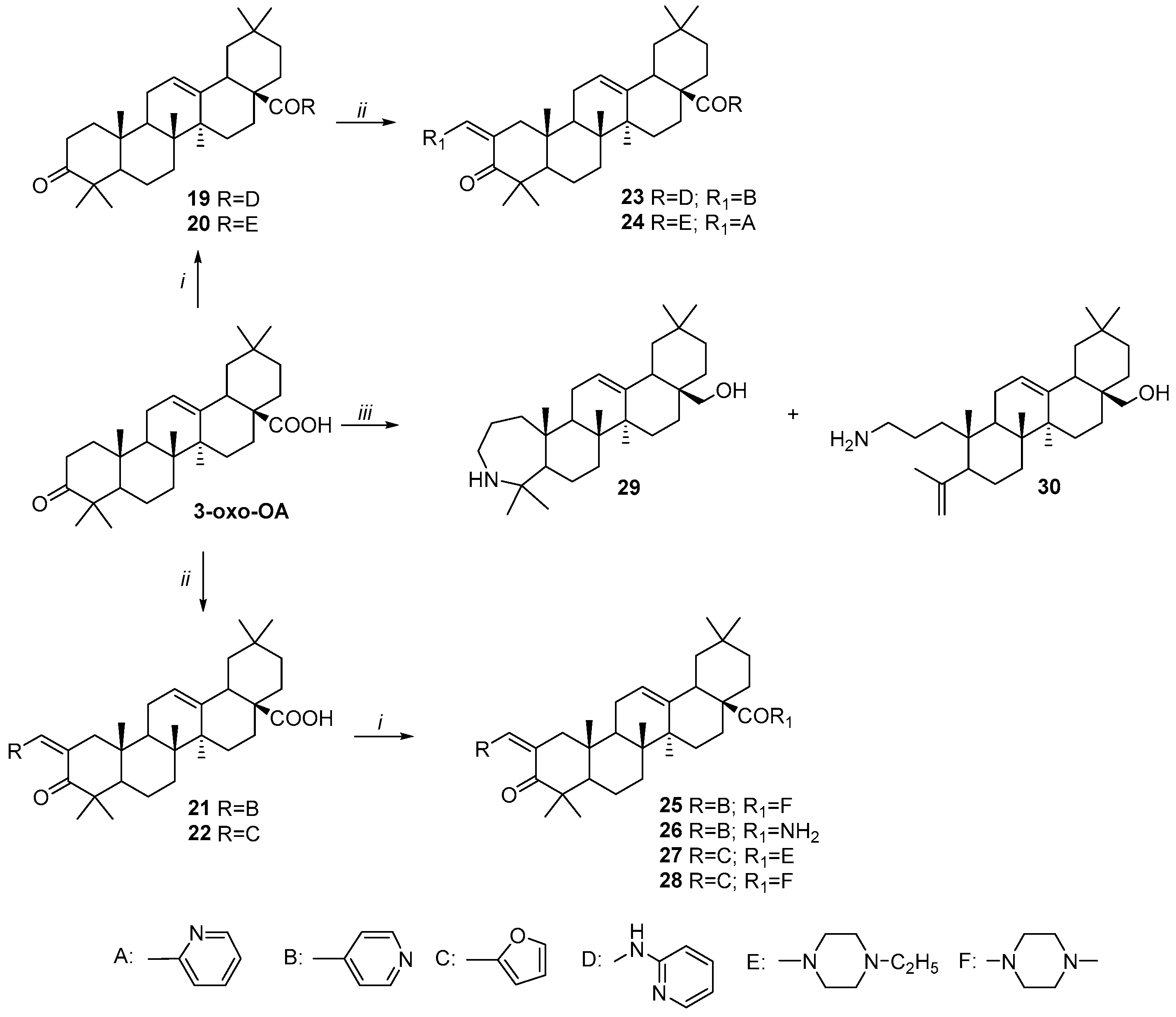
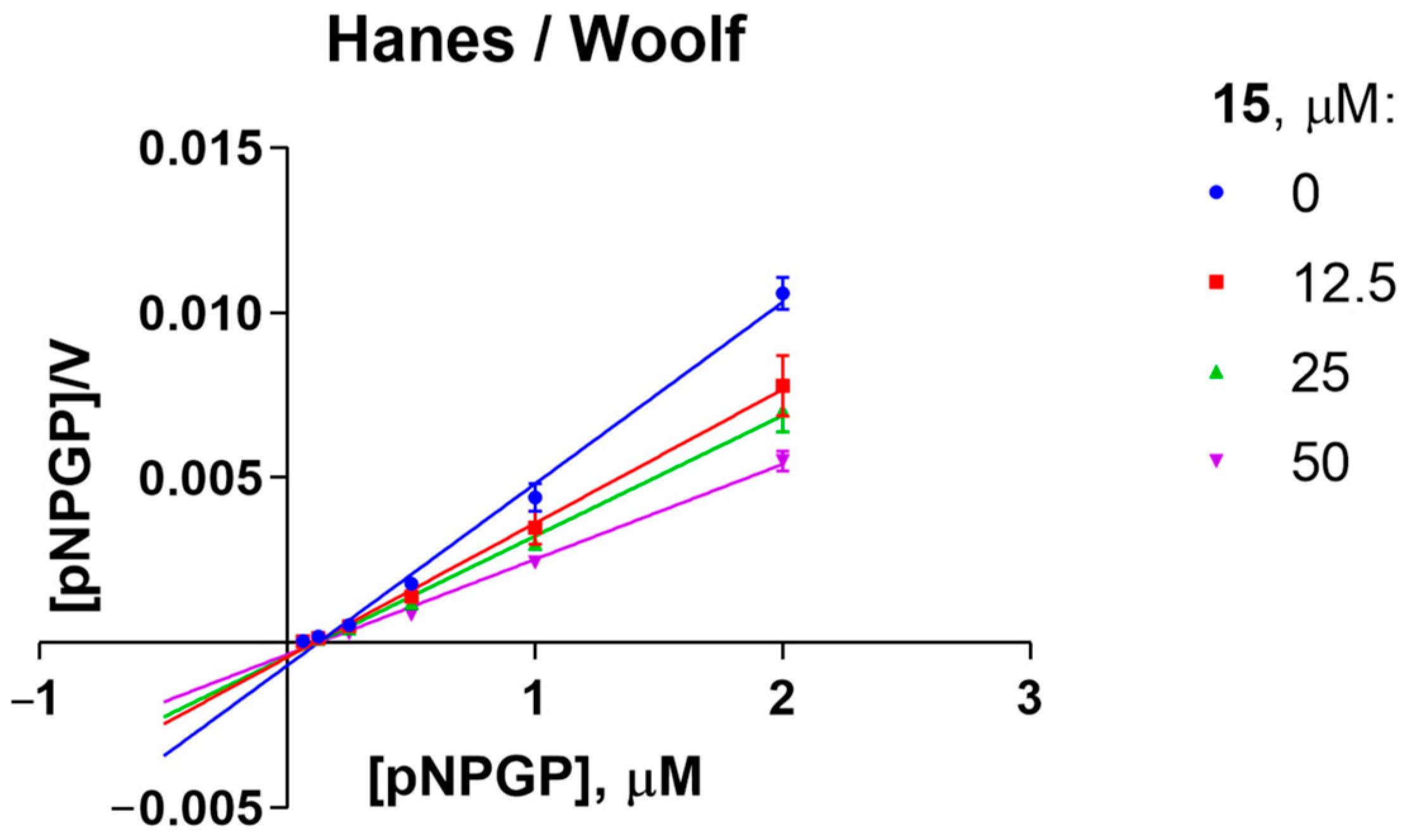
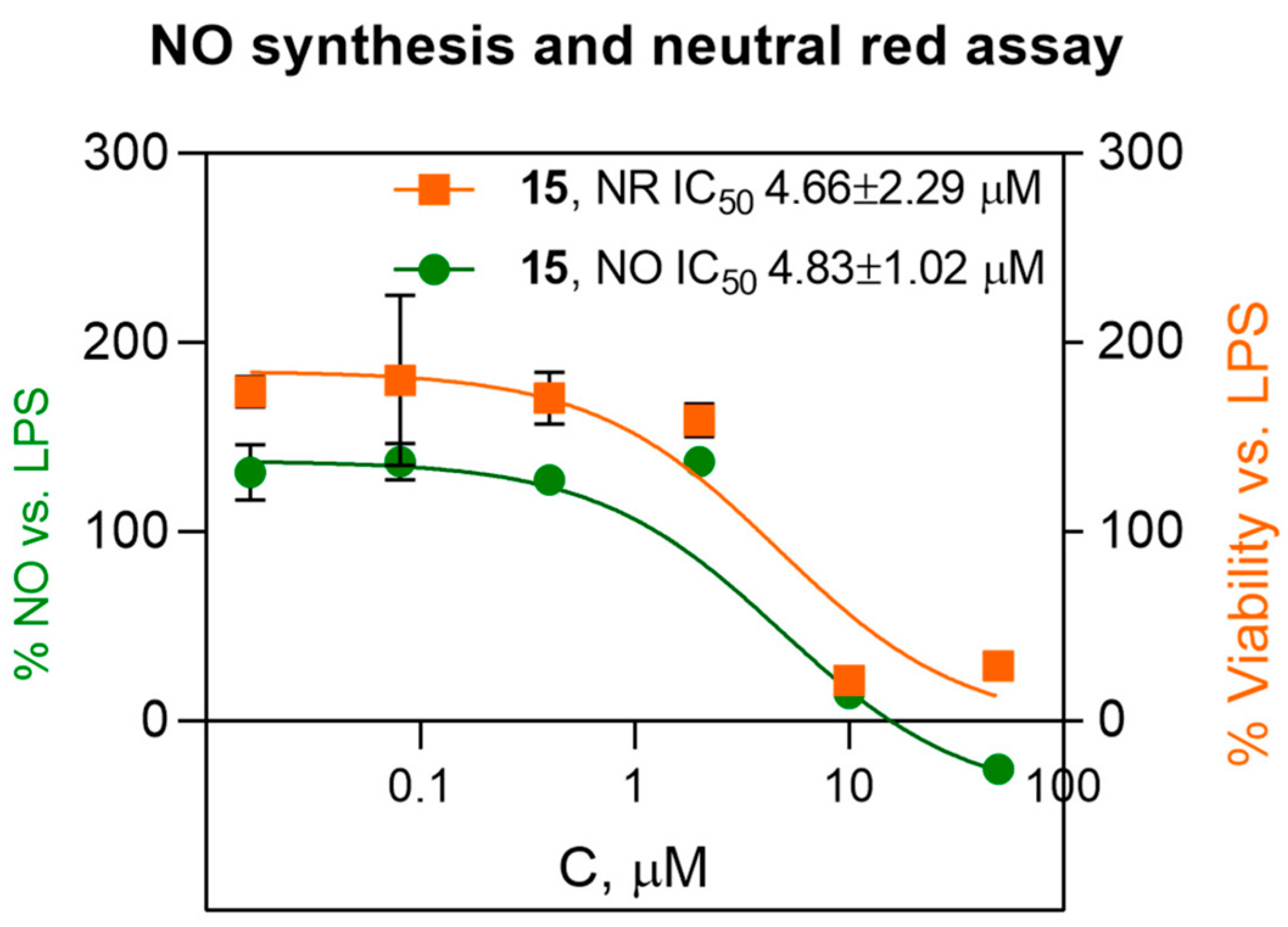

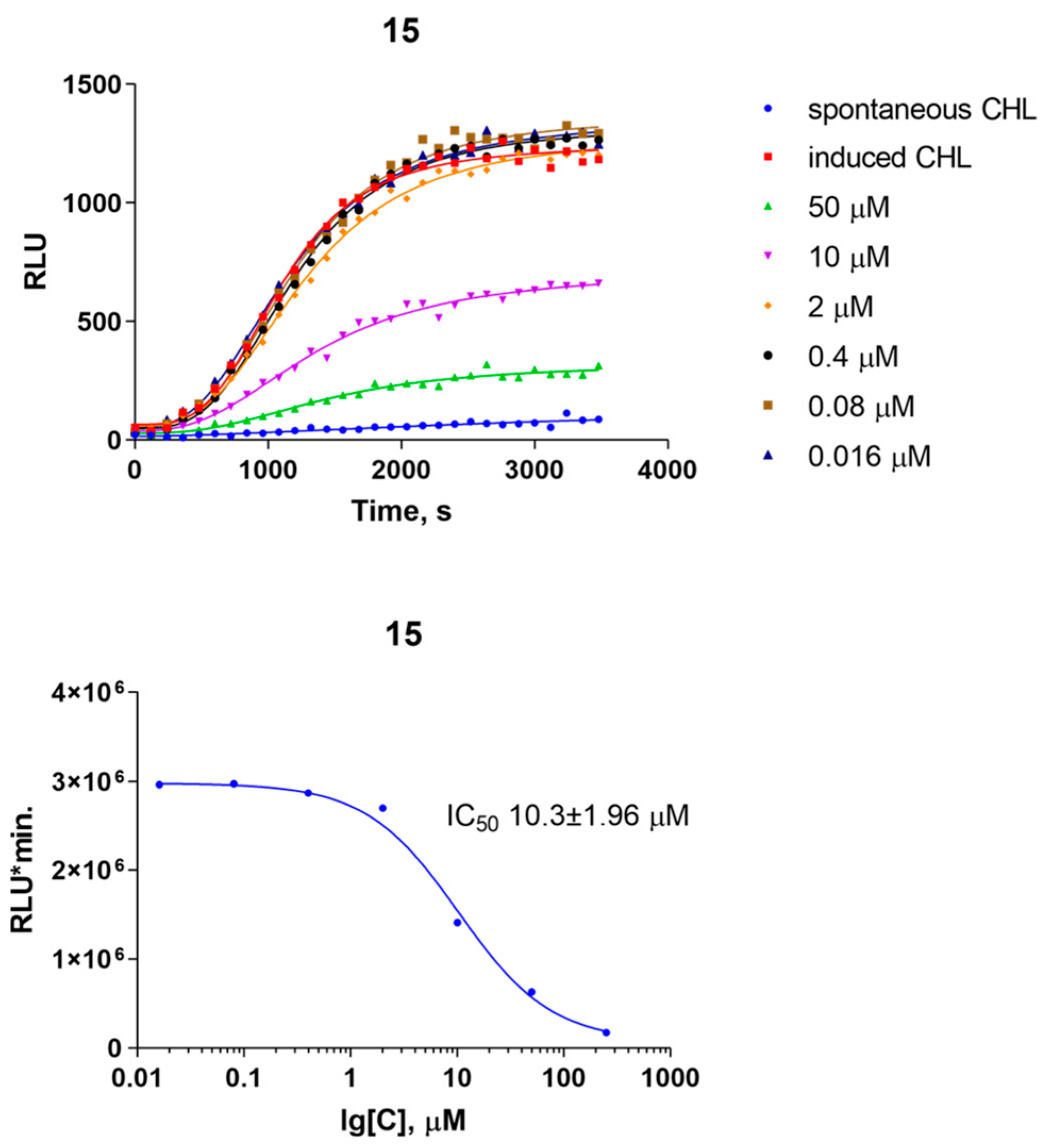
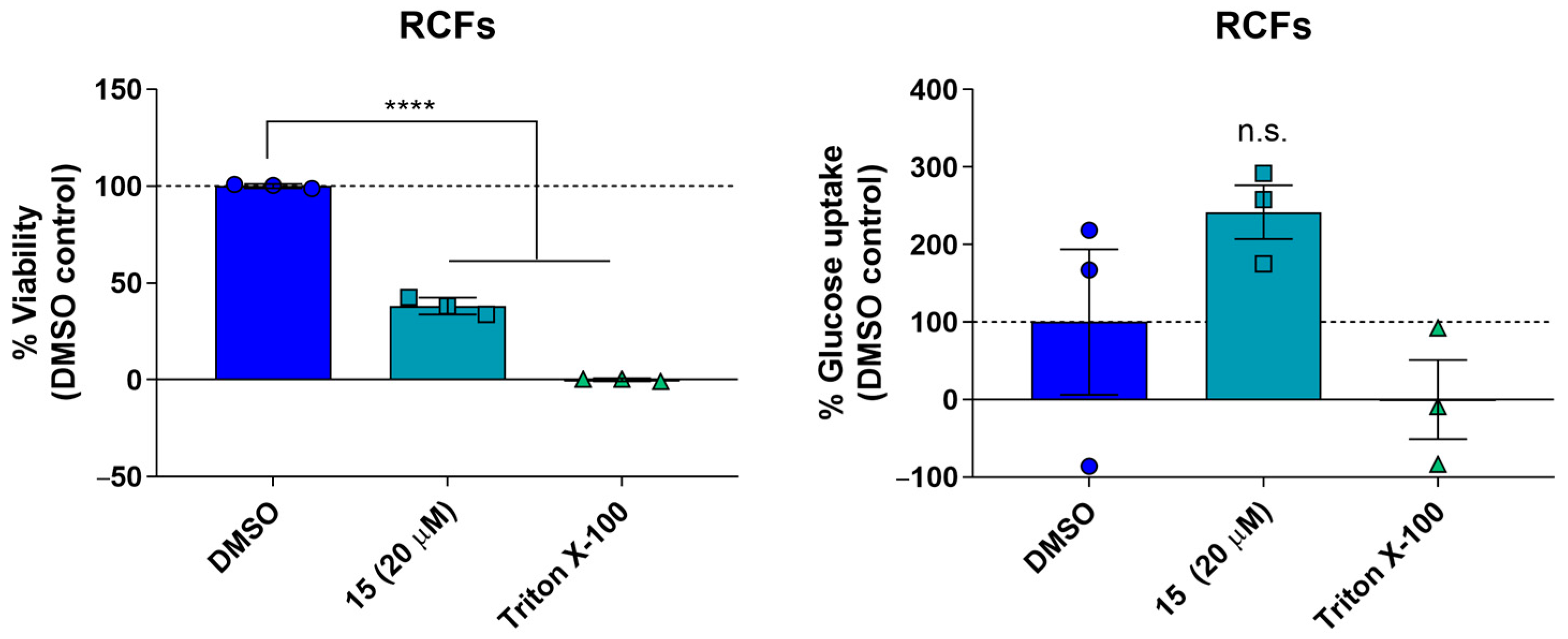

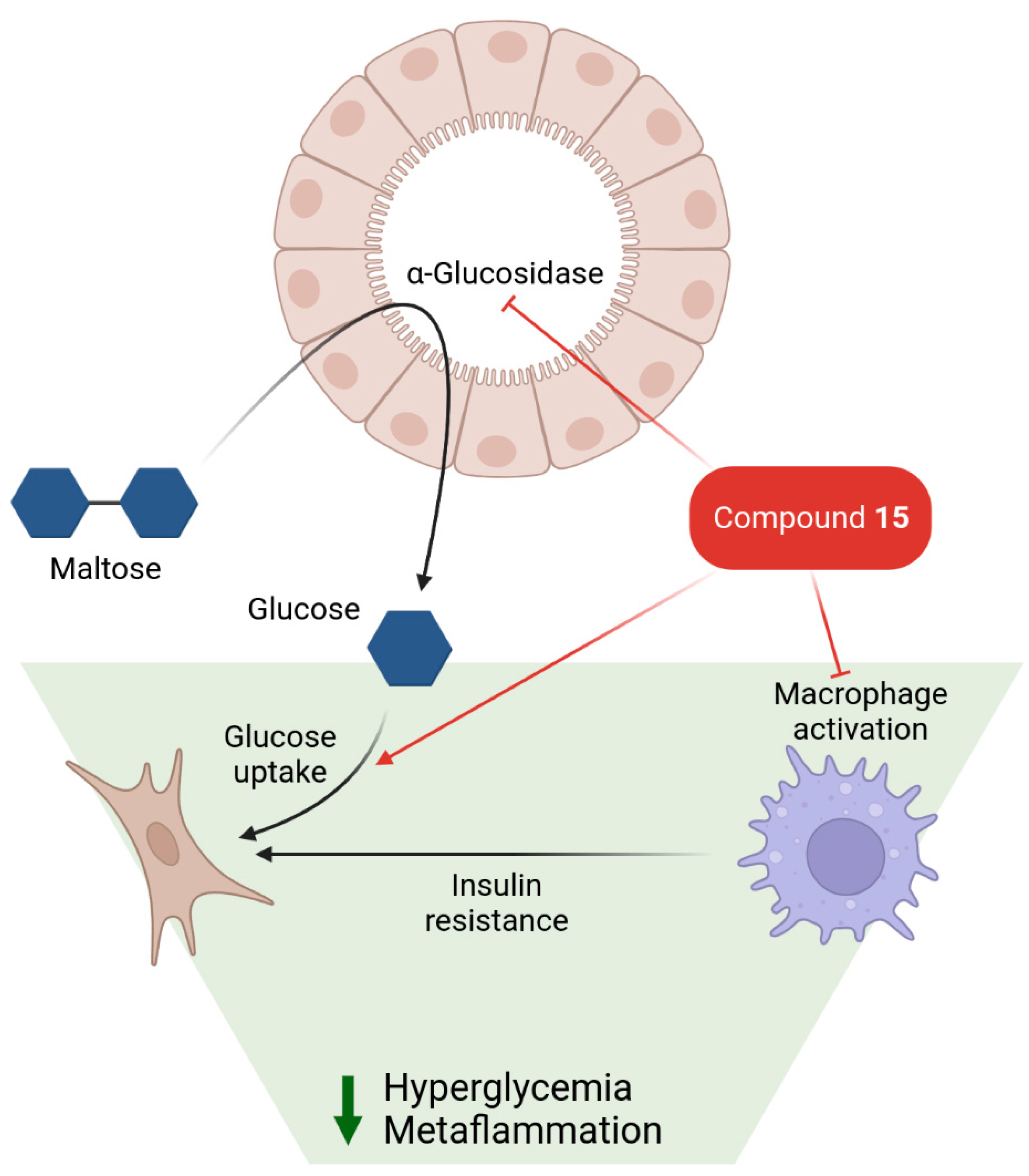
| Cmpd | Glucosidase IC50 ± SD, µM | % NO (10 µM) | % MTT Viability (10 µM) | MTT CC50 (µM) | NO IC50 (µM) |
|---|---|---|---|---|---|
| 4 | 2.4 ± 0.47 | insoluble | insoluble | ||
| 5 | 4.56 ± 1.1 | insoluble | insoluble | ||
| 6 | 752.6 ± 536.5 | insoluble | insoluble | ||
| 7 | >600 | 66.83 | 43.79 | ||
| 8 | 6.5 ± 4.4 | −51.7 | 4.74 | ||
| 9 | 4.5 ± 0.9 | 105.42 | 116.07 | ||
| 10 | >600 | −30.35 | 1.88 | ||
| 11 | 139.1 ± 73.82 | 34.22 | 103.18 | >100 | >100 |
| 12 | 4.71 ± 1.17 | 98.19 | 90.61 | ||
| 13 | 170.2 ± 36.04 | 89.13 | 100.77 | ||
| 14 | 38.3 ± 6.9 | 51.97 | 16.56 | ||
| 15 | 3.01 ± 0.53 | 26.11 | 18.24 | 4.66 | 4.83 |
| 16 | 13.91 ± 3.08 | insoluble | insoluble | ||
| 17 | 223.5 ± 44.19 | insoluble | insoluble | ||
| 18 | 12.37 ± 3.34 | 33.37 | 72.59 | >100 | |
| 19 | 14.2 ± 6.71 | insoluble | insoluble | ||
| 20 | 18.88 ± 7.35 | 59.67 | 140.65 | 39.11 | |
| 21 | 5.56 ± 1.88 | 75.26 | 94.15 | ||
| 22 | inactive | 42.56 | 111.77 | >100 | |
| 23 | 6.6 ± 1.12 | −4.33 | 6.17 | ||
| 24 | inactive | 7.69 | 194.19 | >100 | 7.89 |
| 25 | 79.35 ± 14.04 | 54.7 | 98.83 | 38.17 | |
| 26 | 38.84 ± 6.63 | insoluble | insoluble | ||
| 27 | >600 | −6.13 | 124.59 | 35.2 | 10.71 |
| 28 | inactive | 77.79 | 82.68 | ||
| 29 | inactive | −133.47 | 22.47 | ||
| 30 | 20.5 ± 1 | −66.87 | 2.38 | ||
| Acarbose | 436 | — | — | — | — |
| Dexamethasone | — | 2.01 | 98.77 | >100 | 0.003 |
Disclaimer/Publisher’s Note: The statements, opinions and data contained in all publications are solely those of the individual author(s) and contributor(s) and not of MDPI and/or the editor(s). MDPI and/or the editor(s) disclaim responsibility for any injury to people or property resulting from any ideas, methods, instructions or products referred to in the content. |
© 2023 by the authors. Licensee MDPI, Basel, Switzerland. This article is an open access article distributed under the terms and conditions of the Creative Commons Attribution (CC BY) license (https://creativecommons.org/licenses/by/4.0/).
Share and Cite
Petrova, A.V.; Babkov, D.A.; Khusnutdinova, E.F.; Baikova, I.P.; Kazakova, O.B.; Sokolova, E.V.; Spasov, A.A. α-Glucosidase Inhibitors Based on Oleanolic Acid for the Treatment of Immunometabolic Disorders. Appl. Sci. 2023, 13, 9269. https://doi.org/10.3390/app13169269
Petrova AV, Babkov DA, Khusnutdinova EF, Baikova IP, Kazakova OB, Sokolova EV, Spasov AA. α-Glucosidase Inhibitors Based on Oleanolic Acid for the Treatment of Immunometabolic Disorders. Applied Sciences. 2023; 13(16):9269. https://doi.org/10.3390/app13169269
Chicago/Turabian StylePetrova, Anastasiya V., Denis A. Babkov, Elmira F. Khusnutdinova, Irina P. Baikova, Oxana B. Kazakova, Elena V. Sokolova, and Alexander A. Spasov. 2023. "α-Glucosidase Inhibitors Based on Oleanolic Acid for the Treatment of Immunometabolic Disorders" Applied Sciences 13, no. 16: 9269. https://doi.org/10.3390/app13169269
APA StylePetrova, A. V., Babkov, D. A., Khusnutdinova, E. F., Baikova, I. P., Kazakova, O. B., Sokolova, E. V., & Spasov, A. A. (2023). α-Glucosidase Inhibitors Based on Oleanolic Acid for the Treatment of Immunometabolic Disorders. Applied Sciences, 13(16), 9269. https://doi.org/10.3390/app13169269







